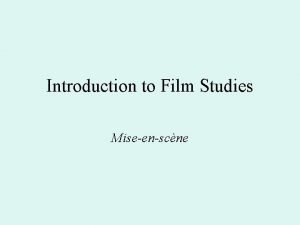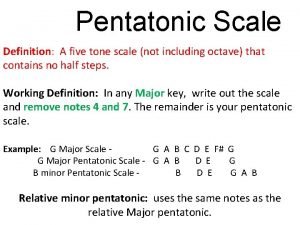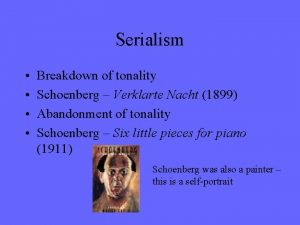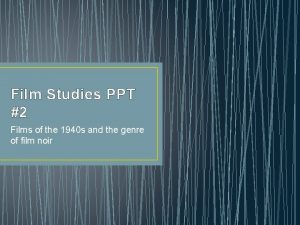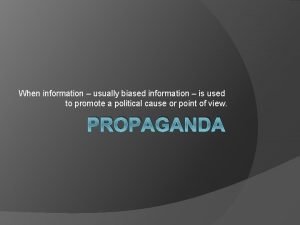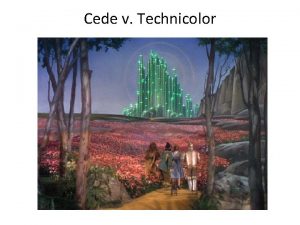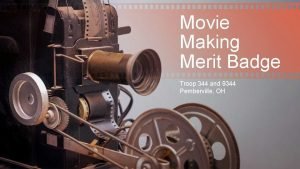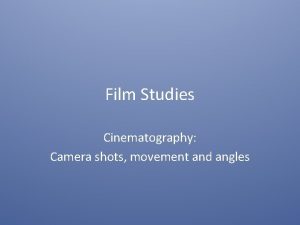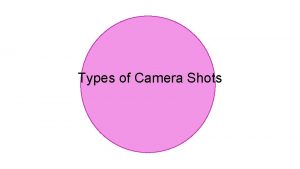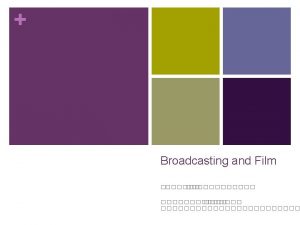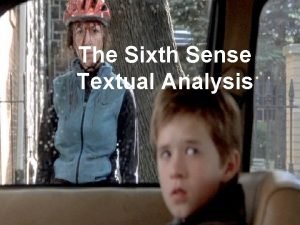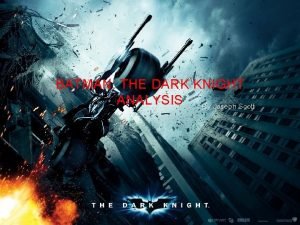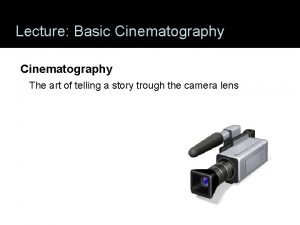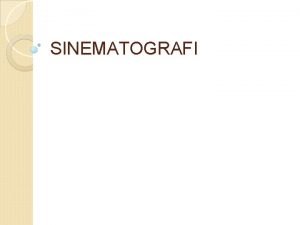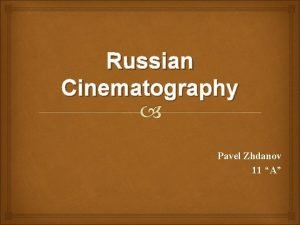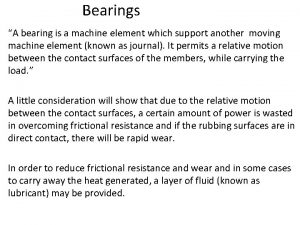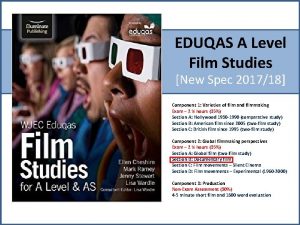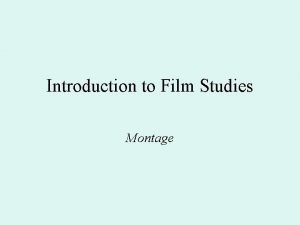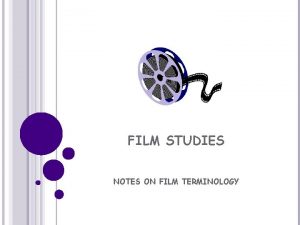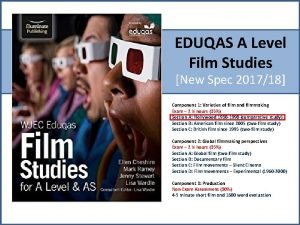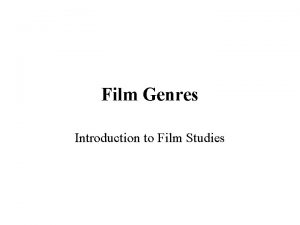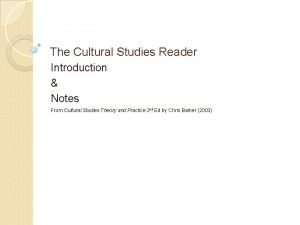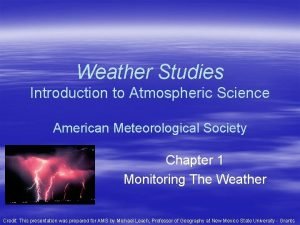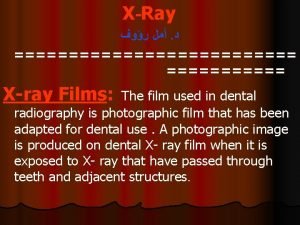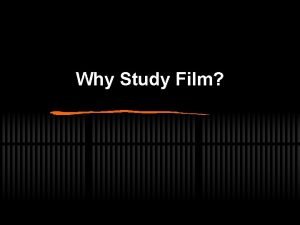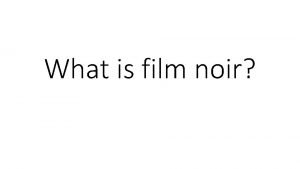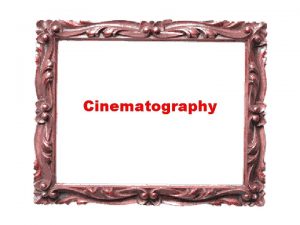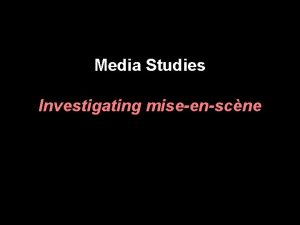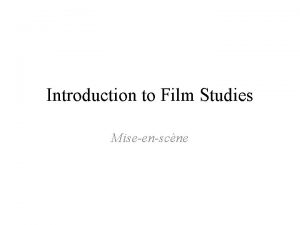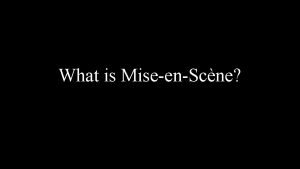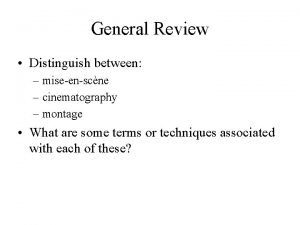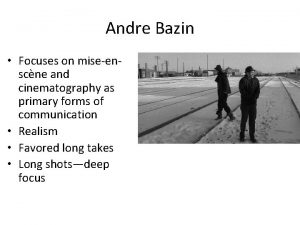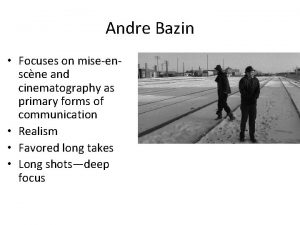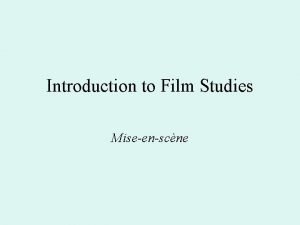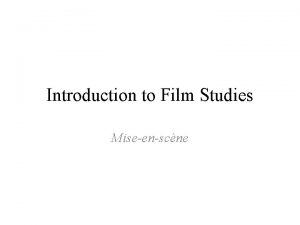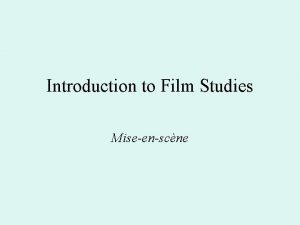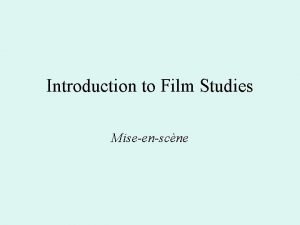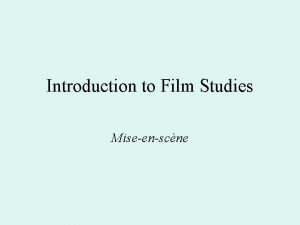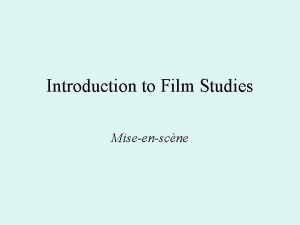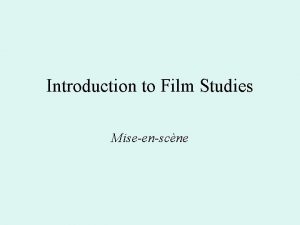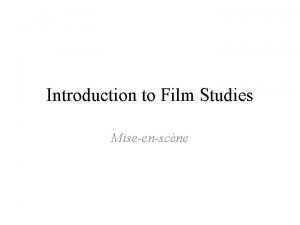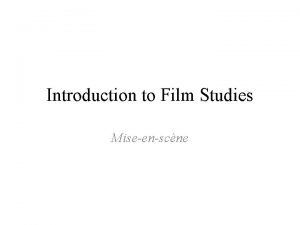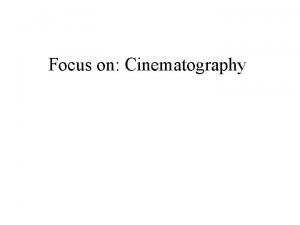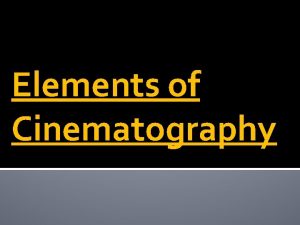Introduction to Film Studies Miseenscne Cinematography Tonality Technicolor

![Cinematography: Tonality • Technicolor [colour film stock] famous for its sharply distinct, heavily saturated Cinematography: Tonality • Technicolor [colour film stock] famous for its sharply distinct, heavily saturated](https://slidetodoc.com/presentation_image_h/37d794e9268efc5c6a7b99ddf1c5a0cb/image-2.jpg)








































- Slides: 42

Introduction to Film Studies Mise-en-scène
![Cinematography Tonality Technicolor colour film stock famous for its sharply distinct heavily saturated Cinematography: Tonality • Technicolor [colour film stock] famous for its sharply distinct, heavily saturated](https://slidetodoc.com/presentation_image_h/37d794e9268efc5c6a7b99ddf1c5a0cb/image-2.jpg)
Cinematography: Tonality • Technicolor [colour film stock] famous for its sharply distinct, heavily saturated hues. Rich colours created by a specially designed camera and a printing process. Vincent Minelli’s Meet Me in St. Louis (1944) The Trolley Song

• Saturated colours continued to be great characteristics of Technicolor Francis Ford Copplola’s Godfather (1972) Death

Cinematography: Tonality • Soviet film stock tended to lower contrast and give the image a murky greenish-blue cast. The monochrome-like colour design in Andrei Tarkovsky’s The Stalker. Actions seem to be taking place underwater. Stalker

Cinematography: Tonality • TINTING - Already developed positive film is immersed in dye. Lighter areas pick up the colour while darker ones remain black and gray. In Abel Gance’s J’accuse! (1919) the image was tinted in pink. J’Accuse

Photography: Tonality • TONING – when dye is added during the developing of the positive print, the darker areas of the frame are coloured and the brighter portions remain white or only faintly coloured. • Veá Chytilová’s Daisies Night Club

Cinematography: Tonality • Hand colouring – Portions of black-and-white images are painted in colours, frame by frame. The ship’s flat in Sergei Eisenstein’s Battleship Potemkin is hand coloured red.

Each frame painstakingly hand coloured in George Méliès A Trip to the Moon

Photography: Tonality • Manipulations of tonalities • Stan Brakhage scratches off the emulsion in certain parts of the image for creating a graphic design. Chinese series

Photography: Tonality • Tonality is the most crucially determined by exposure. Overexposure (too much light admitted through the lens) make the image too bright and underexposure (little light) make the image too dark. Carl Dreyer overexposes the windows to create a religious atmosphere in Ordet. Resurrection

Cinematography: Tonality • Women in the foreground shot in well-exposure, but the sun-lit town in the background is overexposed. • Inside the house a woman is underexposed, while the countryside in the background well-exposed.

Cinematography: Tonality • Filter – a slice of glass or gelatin placed in front of the lens reduces certain frequencies of light reaching the film. Day for Night – A filter can block out part of the light and make footage shot in daylight seem to be shot at night.

Day for night with filter, George Stevens, Shane (1953) Shane, Come back!

Perspective Relations: Lens • Types of camera lenses determined by their focal length – distance between the centre of the lens to the point where light rays converge on the film. • 30 -80 mm – normal lens; under 35 mm – wide-angle lens; over 85 mm – telephoto lens

Perspective Relations: Lens • WIDE ANGLE LENS – a lens with short focal length with a wide angle of view. It exaggerates apparent depth of space and distorts straight lines lying near the edges of the frame.

Perspective Relations: Lens • With wide angle lens a wide area of space is captured. • With telephoto lens an angle of view is very narrow • With normal lens an angle of view is narrower than with wide angle lens but wider than with telephoto

Wide-angle Lens Cinematography • With wide angle lens, our impression of the depth of space is exaggerated. Stanley Kubrick’s Paths of Glory Execution

Wide-angle Lens Cinematography • Short focal length (wideangle) lens - A lens of less than 35 mm in focal length • Distort straight lines lying near the edges of the frame. • Two towers appear to lean rightward and leftward

Nicholas Roeg’s Don’t Look Now

Wide-angle Lens Cinematography • Anything nearer the camera appear to bulge and its shape look distorted. • In Terry Gilliam’s Brazil a wide-angle lens is used extensively


opening

Perspective Relations • The wide-angle lens exaggerate depth. In a scene from William Wyler’s Little Foxes the lens makes the characters seem farther away from each other than we would expect. Arrival

Perspective Relations • Middle focal length (normal) lens – A lens of medium focal length between 35 and 50 mm. • No noticeable perspectival distortion: horizontal and vertical lines are rendered straight and perpendicular • Depth does not look stretched apart or squeezed

Perspective Relations: Lens • TELEPHOTO LENS – a lens of long focal length with a narrow angle of view. It condenses space, flattens depth, and bring distant things close.

Perspective Relations: Lens • Long focal length (telephoto) lens - A lens of long focal length between 80 and 250 mm or more. • It condenses space and flatten the space between what is in the foreground and in the background • The planes seem squashed together • Chen Kaige’s Life on a String

Perspective Relations: Lens • In Godfrey Reggio’s Koyaanisqatsi an airport is shot from a great distance by a telephoto lens. The long lens makes the aeroplane look as if it were landing on a crowded motorway. 25. 15 koyaanisqatsi

Perspective Relations: Lens • Akira Kurosawa frequently used the telephoto lens. In his Red Beard a mad woman walks in a doctor’s room. It is filmed over the shoulder of the doctor and the distance between the two characters appear close at first. When they are shown sideways, the viewer would know that they are far apart.

Perspective Relations: Lens • As the telephoto lens flatten depth, a figure moving towards the camera appears to take more time to cover what seems to be a small distance. • Running-in-place • Mike Nichols’ The Graduate run for elaine

Perspective Relations: Lens • Zoom lens – a lens which can change focal length and transform perspective relations within a single shot. • The zoom lens can substitute for moving the camera forward and backward, as it can magnify and de-magnify the subject. The Conversation

Describe that in Kurosawa Akira’s Kagemusha what lenses are used and what effects do they create.

Describe that in Stanley Kubrick’s Shining what lenses are used and what effects they create. Come play with us

Depth of focus = the range The Lens: Depth of Field and Focus before the lens within which objects can be photographed in sharp focus. A lens with a depth of field of 10 ft (3 m) to infinity renders any object in that range clearly, but anything outside it (e. g. in 4 ft) goes out of focus.

Selective or shallow focus • Only one plane is in focus and the other planes are blurred – shallow focus. David Fincher’s Social Network (2010) A young man’s head in focus, another man in front slightly out of focus, and everybody beyond the central figure completely out of focus. A scene

Depth of Field and Focus • Objects nearer to the camera are thrown out of focus, so that the viewer’s attentions is drawn to the sharper middle ground. • A popular visual style in the 1940 s. • More recent example, Godfather (1972) Sollozzo and Mc. Lusky

Deep or pan focus • A wide-angle lens has a relatively greater depth of field than does a telephoto lens. A scene from Orson Welles’ Citizen Kane – an example of ‘pan’ focus. All the people in this frame are in sharp focus.

Depth of Field and Focus • Faster film stock, wider-angle lens, more intense lighting yield a greater depth of field. Deep focus photography, in which everything is in focus. In Citizen Kane Greg Toland achieved memorable deep focus photography.

Susan’s attempted suicide

Rack focus • Perspective relations can be adjusted by using rack (racking) focus or pulling focus. One object is in focus in one plane and you rack focus so that another thing in another place, which was out of focus, come in focus. Wes Anderson’s Rushmore Swimming pool

Describe the ways in which scenes are focused in Paul Thomas Anderson’s The Master and what effects it creates? The cause

Describe the ways in which scenes are focused in Stephen Spielberg’s Close Encounters of the Third Kind and what kind of effects it creates. Last encounter

Where in the scene is the rack focus found and for what effect is it used? Da vinci code
 Tonality film
Tonality film It is a pentatonic or a five tone scale
It is a pentatonic or a five tone scale Sayang sayang sipatokaan
Sayang sayang sipatokaan Verklärte nacht texture
Verklärte nacht texture Film genres ppt
Film genres ppt Color by technicolor
Color by technicolor Technicolor merger
Technicolor merger Lesson 17 technicolor atoms flame test
Lesson 17 technicolor atoms flame test Technicolor
Technicolor Spm101t
Spm101t Lesson 17 technicolor atoms flame test
Lesson 17 technicolor atoms flame test Technicolor test
Technicolor test Säga upp storytel telia
Säga upp storytel telia Cinematography merit badge
Cinematography merit badge Master wide shot
Master wide shot Citizen kane shot
Citizen kane shot Long shot angle
Long shot angle Chungking express analysis cinematography
Chungking express analysis cinematography Extreme long shot
Extreme long shot The sixth sense cinematography
The sixth sense cinematography Jelaskan apa yang dimaksud dengan floor plan
Jelaskan apa yang dimaksud dengan floor plan Batman the dark knight analysis
Batman the dark knight analysis Basic cinematography rules
Basic cinematography rules Film berasal dari bahasa
Film berasal dari bahasa The spreading of cinematography in russia
The spreading of cinematography in russia Wedge film journal bearing
Wedge film journal bearing A level film studies eduqas
A level film studies eduqas Montage in film studies
Montage in film studies Film studies terminology
Film studies terminology A level film studies past papers
A level film studies past papers Paradigm shift from women studies to gender studies
Paradigm shift from women studies to gender studies Film genre meaning
Film genre meaning Cultural studies
Cultural studies How to write a higher modern studies essay
How to write a higher modern studies essay 12 mark essay higher modern studies
12 mark essay higher modern studies Weather studies introduction to atmospheric science
Weather studies introduction to atmospheric science American meteorological society
American meteorological society An introduction to game studies
An introduction to game studies Essay structure introduction
Essay structure introduction Purpose of lead foil sheet in the film packet
Purpose of lead foil sheet in the film packet How to analyze film
How to analyze film Who invented film
Who invented film Film noir
Film noir
